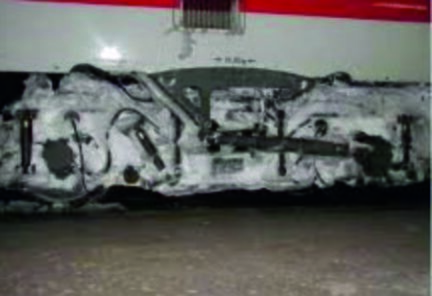Train brakes

A problem area in cold weather in the train carts is their underside. It is in an exposed position, and often has a lot of equipment attached. While it is supposed to be well covered, it is also required to be accessible for maintenance purposes. And even though there is protection from ice and snow, the cold temperature is not as easy to keep out, so the equipment needs to be able to withstand cold.
Underside of the train cart is also where the train brakes are located. Brake system has a lot of moving parts, which can freeze stuck. Some materials commonly used in brake systems, like steel and aluminum, are not suitable to be used in brakes in cold temperatures, because cold contraction changes their geometry. The brake geometry has to be very exact and cold contraction can diminish their braking efficiency. Covering the vulnerable parts and de-icing regularly is vital to keeping the brakes functional during winter.
References
- ↑ Kloow, L. (2011). High-speed train operation in winter climate. KTH Railway Group Publication 1106.
- ↑ Niklas Kandelin: Icing Factors Affecting Railway Traffic Master of Science Thesis Tampere University Master’s Degree Programme, Materials Science October 2021
- ↑ Kloow, L. (2011). High-speed train operation in winter climate. KTH Railway Group Publication 1106.
- ↑ Günay, M. et al. (2020) An investigation on braking systems used in railway vehicles. Engineering science and technology, an international journal. [Online] 23 (2), 421–431.
- ↑ C. Cruceanu (2012). Train Braking, Reliability and Safety in Railway, Dr. Xavier Perpinya (Ed.), InTech.